Finding the perfect haircut for your toddler boy can feel overwhelming, especially when you want to keep his hair longer while maintaining a stylish, manageable look.
22 Longer Toddler Boy Haircuts for a Stylish Look offers a comprehensive guide to help parents navigate the world of extended hairstyles that balance cuteness with practicality.
Longer hair on toddlers provides versatility for different occasions, from casual playdates to family gatherings, while allowing you to express your little one’s emerging personality.
This article explores twenty-two distinct longer haircut options, each designed to work with various hair textures, face shapes, and parenting lifestyles, ensuring you’ll discover styles that keep your toddler looking adorable while minimizing daily styling stress.
Whether you’re seeking something low-maintenance or willing to invest time in grooming, these carefully curated options will inspire you to embrace longer locks for your growing boy.
Contents
- 1 1. Classic Shaggy Cut
- 2 2. Long Top with Tapered Sides
- 3 3. Surfer-Style Flow
- 4 4. Textured Crop with Length
- 5 5. Long Fringe Forward
- 6 6. Layered All-Around Length
- 7 7. Side-Parted Longer Style
- 8 8. Tousled Bedhead Look
- 9 9. Long Curly Top
- 10 10. Faux Hawk with Length
- 11 11. Swept-Back Longer Cut
- 12 12. Long Bangs with Short Sides
- 13 13. Natural Wavy Medium Length
- 14 14. Disconnected Longer Top
- 15 15. Layered Fringe with Flow
- 16 16. Longer Ivy League
- 17 17. Textured Shag with Bangs
- 18 18. Center-Parted Longer Hair
- 19 19. Longer Pompadour Style
- 20 20. Free-Form Longer Curls
- 21 21. Long Top Brushed Forward
- 22 22. Graduated Long Layers
- 23 Styling Tips for Longer Toddler Hair
- 24 Choosing the Right Length for Your Toddler
- 25 Hair Care Products for Longer Toddler Hair
- 26 Managing Tangles in Longer Hair
- 27 Seasonal Considerations for Longer Styles
- 28 Working with Different Hair Textures
- 29 Communicating with Your Child’s Stylist
- 30 When to Transition Back to Shorter Styles
- 31 Building Positive Hair Care Routines
- 32 Budget-Friendly Longer Hair Maintenance
- 33 Health and Safety Considerations
- 34 Cultural and Social Considerations
- 35 Transitioning from Baby Fine Hair
- 36 Conclusion
1. Classic Shaggy Cut
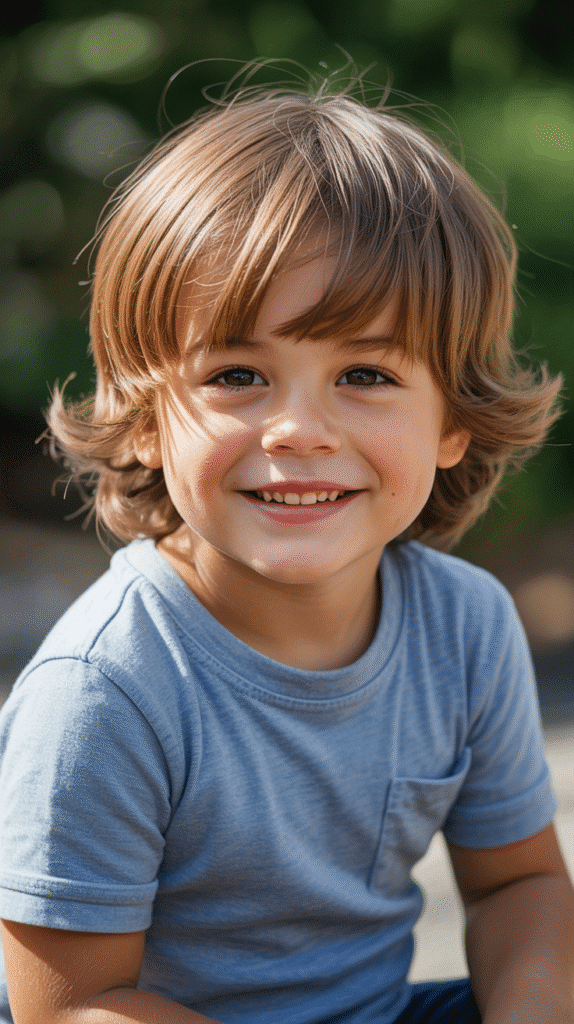
The classic shaggy cut remains a timeless favorite among parents who want their toddler boys to sport longer hair with minimal fussing.
This effortlessly cool style works beautifully with natural texture and provides movement that looks charming during active play.
- The shaggy cut typically features hair length between 2-4 inches throughout, with slightly longer pieces around the crown and shorter sections near the nape.
- This style works exceptionally well for toddlers with wavy or straight hair textures, creating natural volume without requiring extensive styling products.
- Parents appreciate how the shaggy cut grows out gracefully, extending time between salon visits to approximately 8-10 weeks.
- The layered nature of this haircut prevents the heavy, flat appearance that can occur with blunt cuts on fine toddler hair.
- Styling requires only a quick towel-dry and finger-combing through damp hair, making morning routines significantly easier.
- The shaggy cut frames the face softly, complementing round and oval face shapes particularly well.
2. Long Top with Tapered Sides
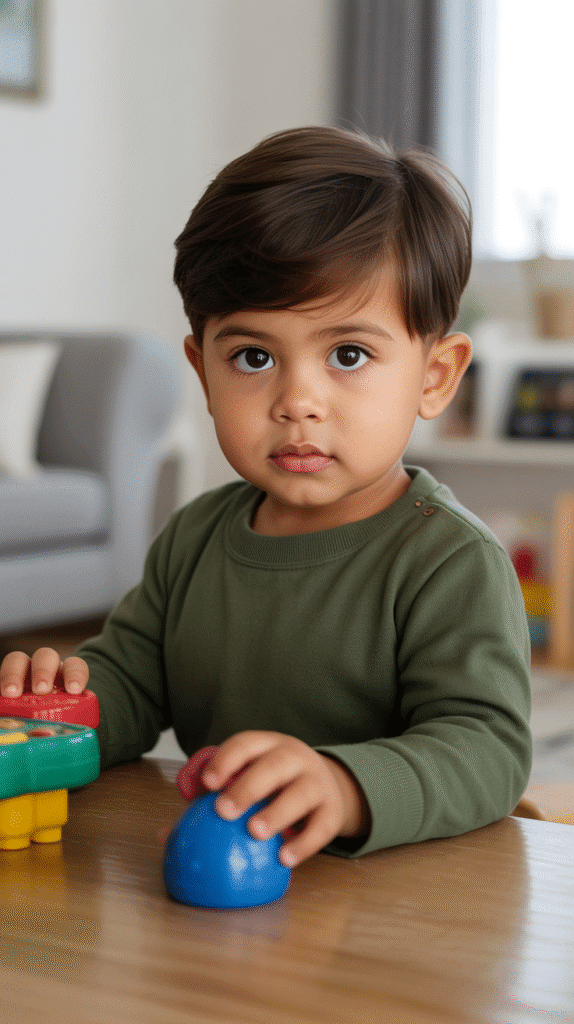
The long top with tapered sides offers a modern twist on longer toddler hairstyles, combining trendy barbering techniques with extended length on top.
This sophisticated option provides the best of both worlds for parents wanting length without excessive maintenance.
- The top section maintains 3-5 inches of length, allowing for various styling options from slicked back to tousled forward.
- Tapered sides gradually shorten from approximately 1 inch at the temples to shorter lengths near the ears and neckline.
- This haircut reduces heat discomfort during warmer months while preserving the longer hair aesthetic parents desire.
- The contrast between longer and shorter sections creates visual interest that photographs beautifully.
- Toddlers with thick hair benefit particularly from this cut as it removes bulk from the sides while showcasing texture on top.
- The style adapts well to both formal occasions with light styling products and casual settings with a natural, air-dried finish.
- Regular trims every 4-6 weeks maintain the tapered sides while allowing continuous length growth on top.
3. Surfer-Style Flow

The surfer-style flow brings beach-inspired coolness to toddler boy haircuts, featuring longer lengths that cascade naturally around the face and neck.
This carefree style celebrates movement and works wonderfully for active children.
- Hair length typically ranges from 4-6 inches throughout, creating the signature flowing appearance associated with surfer aesthetics.
- This cut works best with naturally wavy or curly textures, though straight-haired toddlers can achieve similar looks with slight modifications.
- The surfer flow requires minimal cutting technique, often involving simple length maintenance and occasional texturizing to prevent excessive bulk.
- Parents value this style for its wash-and-wear nature, as the hair naturally falls into place when air-dried.
- The flowing hair provides sun protection for the neck and ears during outdoor activities.
- This haircut particularly suits toddlers with longer faces, as the horizontal volume softens angular features.
- Conditioning treatments become more important with this length to prevent tangling and maintain hair health.
4. Textured Crop with Length
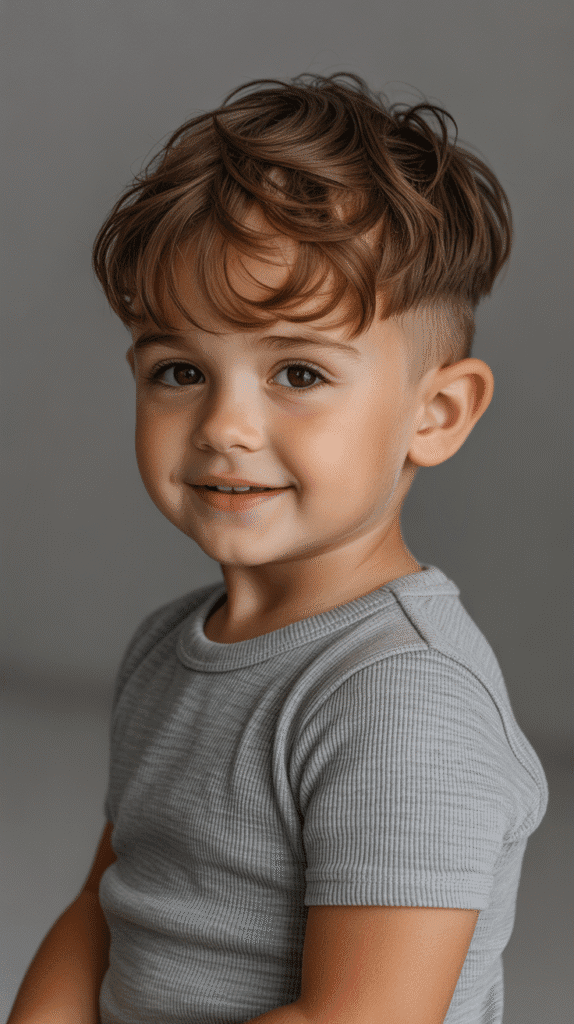
The textured crop with length represents a contemporary approach to longer toddler haircuts, incorporating modern barbering techniques that add dimension and style.
This option appeals to fashion-forward parents seeking something beyond traditional cuts.
- The haircut maintains 2-3 inches of length throughout while utilizing point-cutting and texturizing techniques to create movement.
- Strategic layering prevents the mushroom-shaped appearance that sometimes occurs with longer toddler hair.
- This style works across all hair types, from fine and straight to thick and coarse textures.
- The textured finish reduces the need for styling products, as the cut itself creates natural separation and definition.
- Parents find this option particularly practical because it looks intentionally styled even when simply air-dried.
- The crop grows out attractively, maintaining its shape for 6-8 weeks between appointments.
- Face-framing pieces can be customized to complement specific facial features and head shapes.
5. Long Fringe Forward
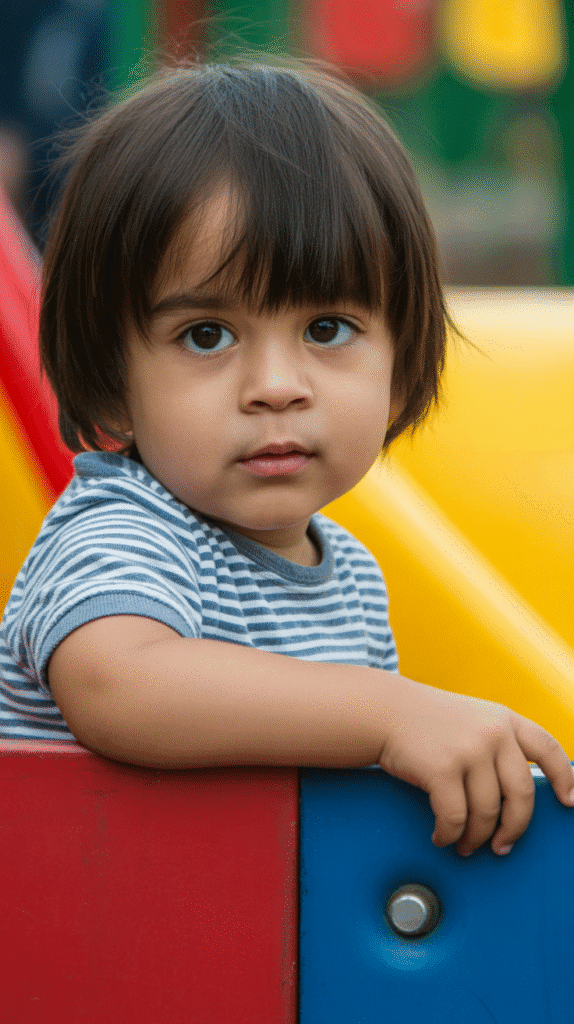
The long fringe forward style showcases longer bangs that sweep across the forehead, creating an adorable, youthful appearance that many parents adore.
This classic approach to longer hair emphasizes the face while maintaining practical length elsewhere.
- The fringe typically measures 3-4 inches, falling naturally across the forehead and sometimes reaching the eyebrows.
- Back and side lengths remain moderate at 2-3 inches, balancing the prominent fringe without overwhelming the overall look.
- This haircut particularly flatters toddlers with high foreheads or rectangular face shapes by creating proportion.
- The forward-swept fringe requires occasional trimming between full haircuts to keep it from obstructing vision.
- Parents can style the fringe to the side for variety, offering two distinct looks from one haircut.
- This style works beautifully with straight to slightly wavy hair textures, though very curly hair may require more frequent adjustments.
- The long fringe provides a signature look that photographs exceptionally well and creates memorable early childhood images.
6. Layered All-Around Length
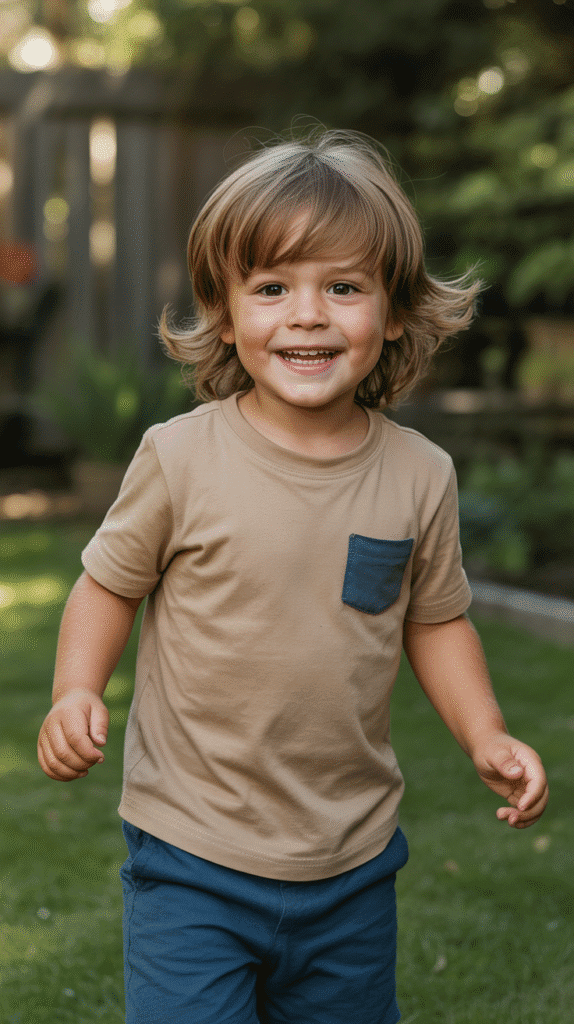
The layered all-around length haircut delivers uniform longer hair with strategic layering that prevents heaviness and promotes natural movement.
This versatile option suits parents committed to maintaining genuinely longer hair on their toddler boys.
- Hair length ranges from 3-5 inches throughout the head, with subtle layering creating dimension without dramatic length variation.
- The layered technique removes bulk at the ends while maintaining overall length, making hair more manageable during washing and drying.
- This style accommodates all hair textures, though the specific layering approach adjusts based on whether hair is straight, wavy, or curly.
- Toddlers with thick hair particularly benefit from internal layering that reduces weight while preserving the appearance of fullness.
- The all-around length requires commitment to regular detangling, especially after naps and before bedtime.
- Parents should invest in quality children’s hair care products, including detangling sprays and conditioning treatments.
- This haircut grows out beautifully over 10-12 weeks, making it cost-effective despite requiring more daily maintenance.
7. Side-Parted Longer Style
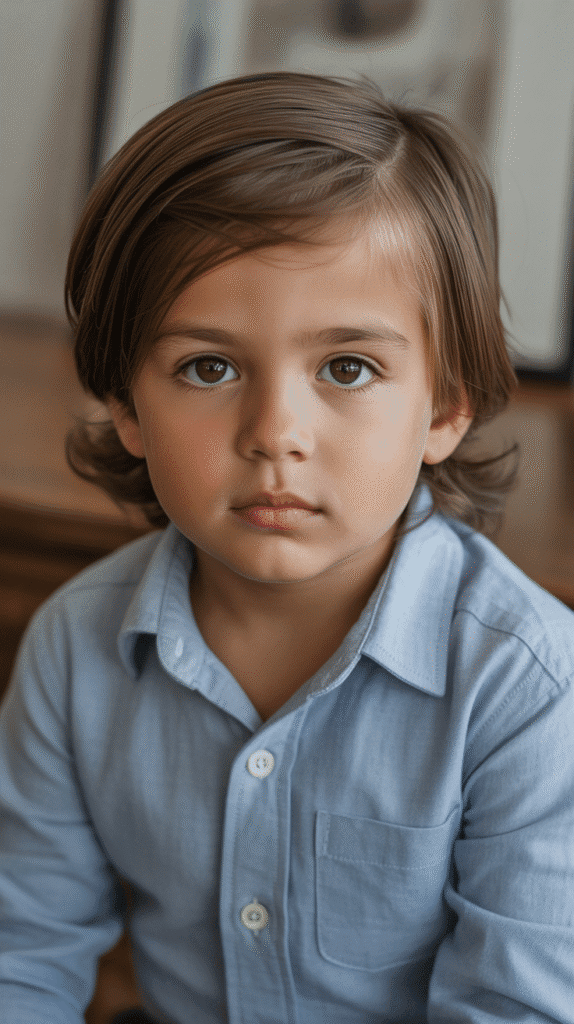
The side-parted longer style introduces a touch of sophistication to toddler boy haircuts while maintaining the desired length parents seek.
This polished option works wonderfully for both everyday wear and special occasions.
- Hair length measures approximately 3-4 inches on top, allowing the side part to remain defined while providing styling flexibility.
- Sides and back typically taper slightly shorter than the top, creating a refined silhouette without dramatic contrast.
- The defined side part adds structure to the haircut, making it appear more intentional and groomed than unstyled longer cuts.
- This style particularly complements formal settings like family portraits, holidays, and celebrations.
- Creating the part requires only a comb run through damp hair, establishing a routine that takes less than thirty seconds.
- The side-parted style works best with straight to moderately wavy hair, as very curly textures may not hold the parting as distinctly.
- Regular conditioning prevents the parted hair from looking dry or damaged, maintaining the polished appearance.
8. Tousled Bedhead Look

The tousled bedhead look embraces natural texture and carefree styling, creating an adorable, effortlessly cool appearance that suits active toddler lifestyles.
This intentionally undone style celebrates childhood spontaneity.
- Hair length varies between 2-4 inches with choppy, irregular layering that creates the signature tousled appearance.
- The cutting technique involves point-cutting and texturizing that encourages hair to fall in multiple directions naturally.
- This style eliminates morning styling stress, as the “messy” look is actually the intended result.
- Parents can enhance the texture with a small amount of lightweight styling product or simply leave hair to air-dry naturally.
- The bedhead look works particularly well for toddlers with fine to medium hair thickness that might appear flat with other cuts.
- This haircut flatters most face shapes, adding width to narrow faces and softness to square jawlines.
- The low-maintenance nature makes it ideal for busy families juggling multiple children or demanding schedules.
9. Long Curly Top

The long curly top celebrates natural curl patterns, allowing toddler boys with curly hair to showcase their beautiful texture at longer lengths.
This style honors natural hair characteristics rather than fighting against them.
- Curly hair at 3-5 inches creates stunning volume and definition that becomes a signature feature of the child’s appearance.
- The cutting approach focuses on shape and curl pattern rather than precise length, as curls behave differently than straight hair.
- Hydration becomes crucial with longer curly hair, requiring leave-in conditioners and curl-defining products designed for children.
- This style works best when hair is cut dry, allowing the stylist to see exactly how curls naturally fall and form.
- Parents should establish a gentle detangling routine using wide-tooth combs on wet, conditioned hair to prevent breakage.
- The long curly top suits all face shapes, though the volume particularly benefits toddlers with longer or narrower facial structures.
- Refreshing curls between washes involves light misting with water and curl refresher sprays rather than complete washing.
10. Faux Hawk with Length
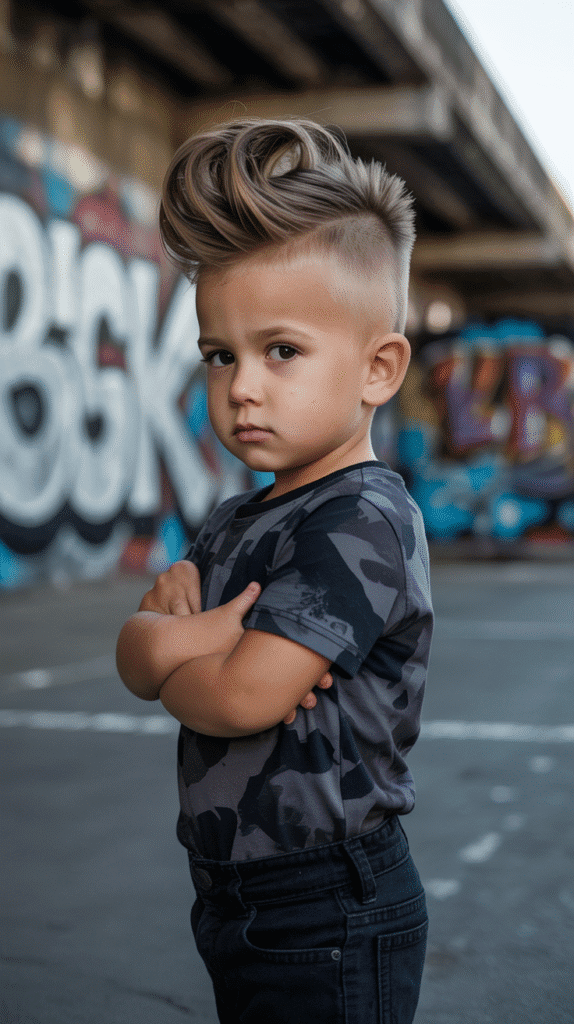
The faux hawk with length brings edgy style to the toddler haircut world while maintaining longer hair that parents appreciate.
This modern option creates visual interest through shape rather than extreme length contrast.
- The center section maintains 3-4 inches of length, styled upward and slightly forward to create the faux hawk shape.
- Side sections measure approximately 1-2 inches shorter, providing enough contrast for definition without requiring extreme tapering.
- This style allows for versatile styling—worn as a faux hawk for special occasions or simply combed forward for everyday activities.
- A small amount of lightweight styling product helps maintain the upward lift when the faux hawk look is desired.
- The haircut grows out gracefully into a general longer style, extending time before the next cut is necessary.
- Toddlers with straight to slightly wavy hair achieve the most dramatic faux hawk effect, though curly hair creates unique textured versions.
- This option particularly appeals to parents wanting their child to stand out stylishly without committing to more extreme haircuts.
11. Swept-Back Longer Cut
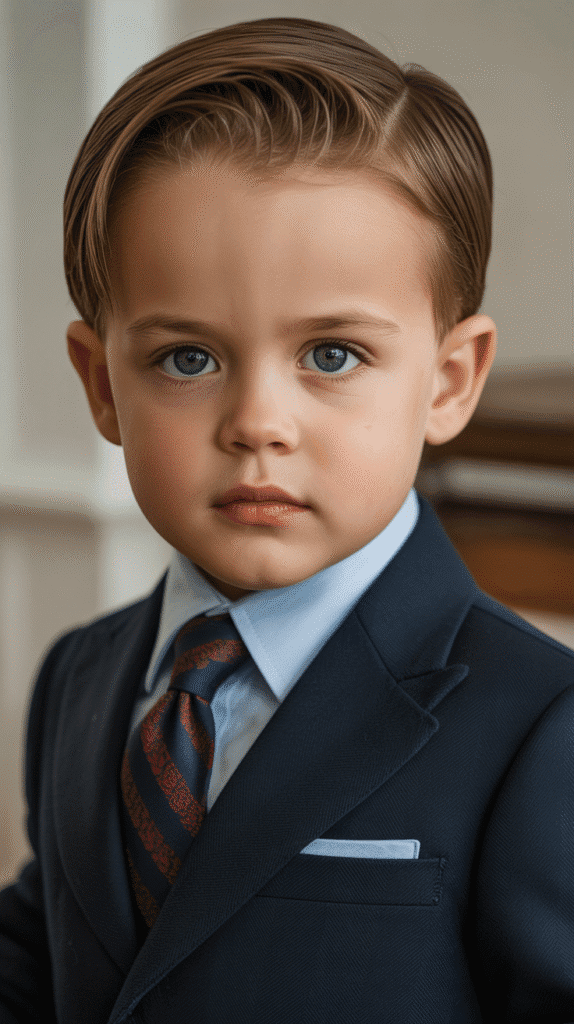
The swept-back longer cut introduces a refined, mature element to toddler hairstyles while preserving the length parents desire.
This elegant option works beautifully for children who tolerate some styling attention.
- Hair length ranges from 3-5 inches throughout, with slightly longer pieces on top that sweep backward from the hairline.
- The styling direction creates a clean face-framing effect that keeps hair from falling into eyes during activities.
- A minimal amount of lightweight styling cream or gel helps maintain the swept-back shape throughout the day.
- This haircut particularly suits formal occasions, making it ideal for toddlers who attend events requiring more polished appearances.
- The swept-back style works best with straight to wavy hair, as very curly textures may resist the backward direction.
- Parents can easily achieve this look by combing damp hair backward after bath time, allowing it to air-dry in position.
- The mature appearance photographs beautifully, creating timeless images that families treasure for years.
12. Long Bangs with Short Sides
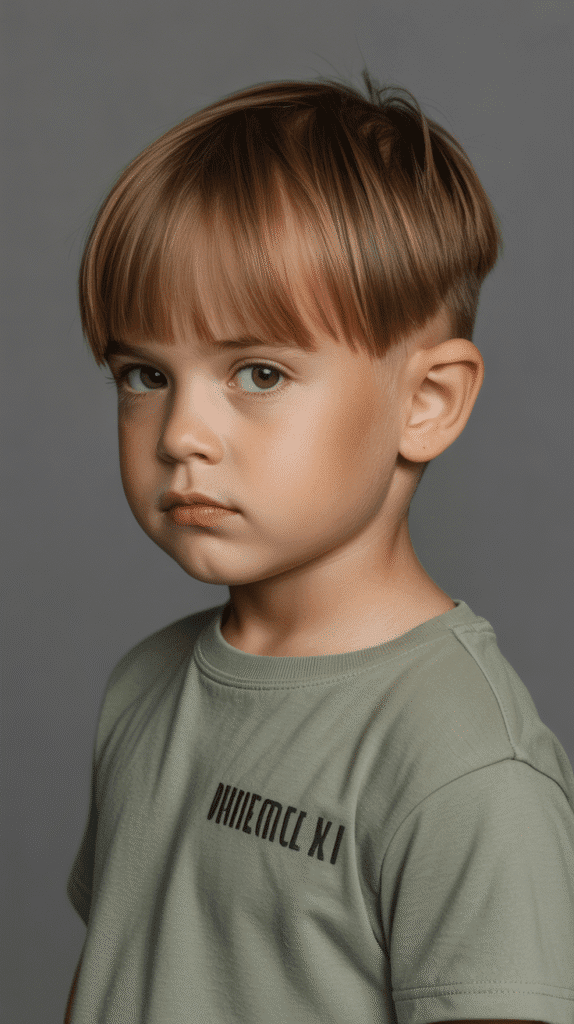
The long bangs with short sides combination creates striking contrast while maintaining the longer hair element on top.
This contemporary style offers practical benefits alongside fashionable appearance.
- Bangs measure 3-4 inches, sweeping across the forehead and sometimes requiring periodic side-pinning or trimming.
- Sides and back taper to approximately 0.5-1 inch, providing cooling comfort and reducing overall maintenance requirements.
- The dramatic length difference makes this haircut visually interesting and photographically dynamic.
- This style particularly benefits toddlers with thick hair, as removing bulk from sides prevents overheating while showcasing density on top.
- The long bangs can be styled in multiple directions—forward, swept to the side, or even temporarily pushed back with headbands.
- Regular trims every 4-5 weeks maintain the short sides while allowing continued growth of the longer fringe.
- This haircut suits most face shapes, though it particularly enhances round faces by adding vertical visual interest.
13. Natural Wavy Medium Length
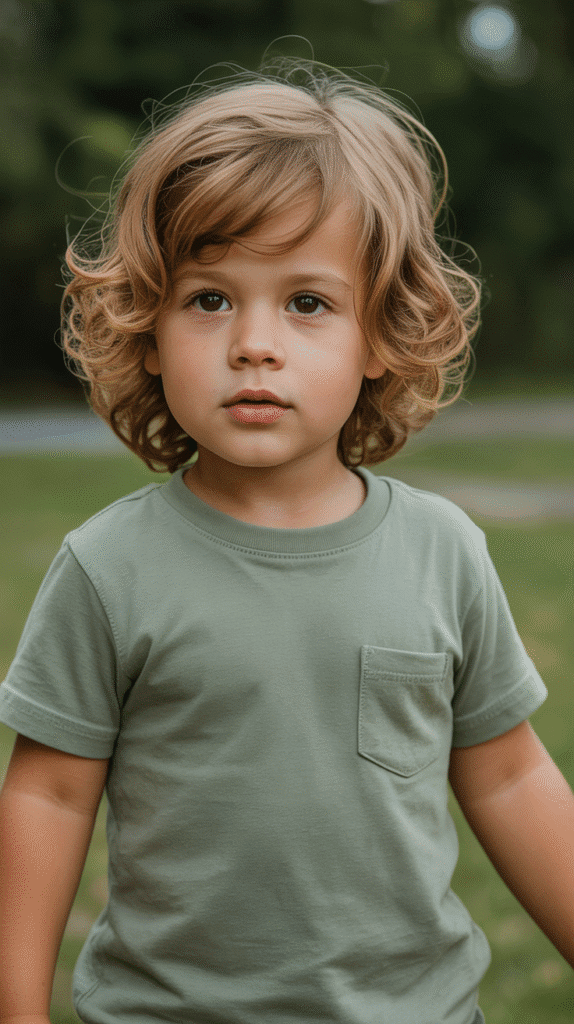
The natural wavy medium length haircut embraces the beautiful wave patterns many toddler boys naturally possess, allowing hair to reach lengths that showcase this texture fully.
This style celebrates natural hair characteristics with minimal intervention.
- Hair length extends to 3-4 inches throughout, providing sufficient length for wave patterns to fully develop and display.
- The cutting technique preserves weight and density that wavy hair needs to form defined wave patterns rather than frizz.
- This style requires minimal product application, often just a leave-in conditioner to enhance wave definition and reduce tangles.
- Parents should allow wavy hair to air-dry whenever possible, as blow-drying can disrupt natural wave patterns and create frizz.
- The natural wavy look works across all face shapes, adding softness to angular features and interest to rounder faces.
- This haircut particularly suits toddlers whose waves become more pronounced as hair grows longer, justifying the extended length.
- Regular deep conditioning treatments maintain hair health and enhance wave definition without weighing down the texture.
14. Disconnected Longer Top
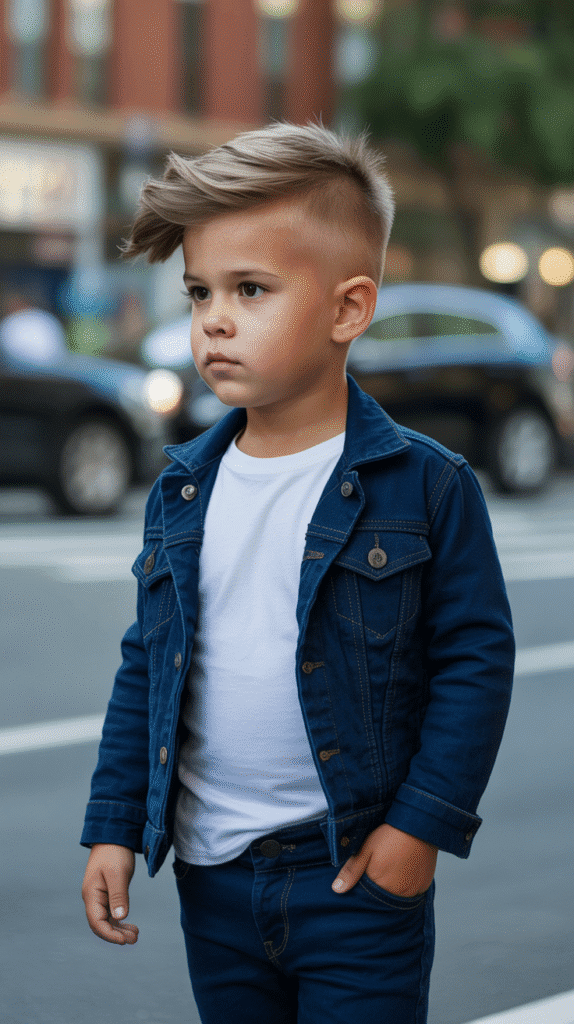
The disconnected longer top represents an advanced barbering technique that creates intentional length separation between top and sides.
This fashion-forward option appeals to style-conscious parents seeking something distinctive.
- The top section maintains 4-5 inches of length with minimal layering, creating a defined horizontal line where it meets shorter sides.
- Sides measure approximately 0.5-1 inch, creating stark contrast that emphasizes the longer top section dramatically.
- This haircut requires precision cutting skills, making it important to choose experienced children’s stylists familiar with disconnection techniques.
- The disconnected look allows for multiple styling options on top—slicked back, pushed forward, or left naturally tousled.
- This style works best with straight to slightly wavy hair, as the disconnection line appears most crisp with these textures.
- Toddlers with thick hair showcase this cut particularly well, as density on top creates impressive volume and presence.
- The maintenance schedule includes trimming sides every 3-4 weeks while leaving top length to grow continuously if desired.
15. Layered Fringe with Flow

The layered fringe with flow combines textured bangs with overall longer length, creating movement and dimension throughout the entire haircut.
This dynamic option provides visual interest from every angle.
- The fringe section features multiple layers ranging from 2-4 inches, creating cascading pieces that move independently.
- Overall hair length maintains 3-4 inches throughout sides and back, ensuring the fringe doesn’t overwhelm the total look.
- Layering throughout the haircut prevents the heavy, helmet-like appearance that can occur with blunt, long cuts.
- This style works beautifully with all hair textures, though the specific layering technique adjusts based on whether hair is straight, wavy, or curly.
- The flowing movement makes this haircut particularly photogenic, capturing beautifully in both still images and videos.
- Parents can style the layered fringe in various directions depending on the occasion and desired appearance.
- Regular texturizing appointments every 8-10 weeks maintain the layered effect without sacrificing overall length.
16. Longer Ivy League

The longer ivy league adapts the classic preppy haircut by extending lengths while maintaining its sophisticated character.
This refined option bridges traditional styling with contemporary longer hair preferences.
- Top hair measures 2-3 inches, significantly longer than traditional ivy league cuts while preserving the style’s essential structure.
- Sides and back taper from approximately 1 inch at the top gradually down to shorter lengths near the ears and neckline.
- The longer adaptation allows for more styling versatility than classic ivy league cuts, including forward, side, or back styling.
- This haircut particularly suits formal environments and families who value traditional aesthetic values with modern updates.
- The style works best with straight to moderately wavy hair, creating clean lines and defined shapes.
- A small amount of styling product helps maintain neatness throughout the day, though the cut looks acceptable even without products.
- This option appeals to parents seeking longer hair that still appears well-groomed and intentionally styled rather than simply grown out.
17. Textured Shag with Bangs
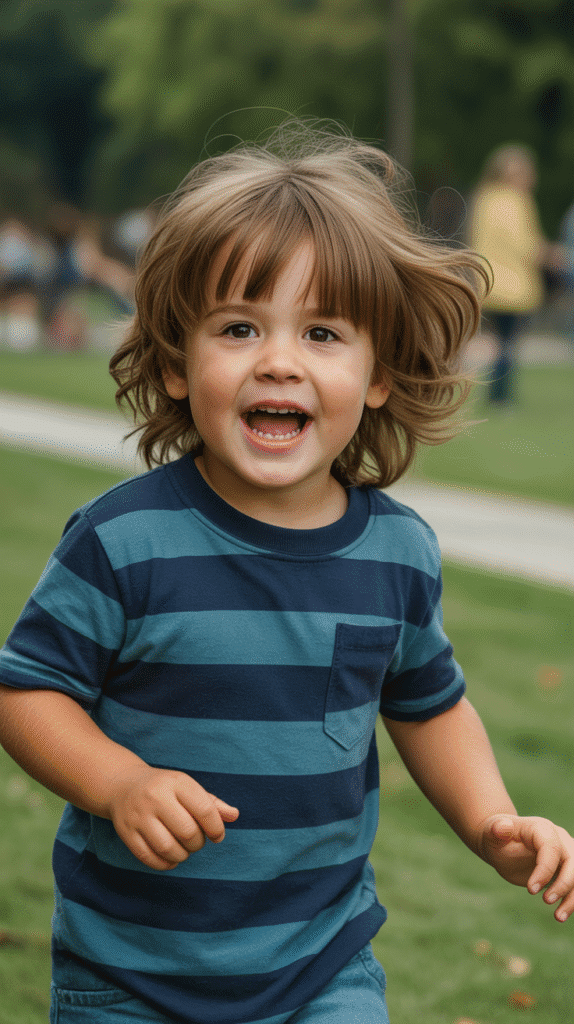
The textured shag with bangs delivers maximum movement and dimension through extensive layering combined with prominent fringe.
This playful style captures youthful energy while providing practical longer hair benefits.
- Hair length varies from 2-4 inches throughout, with irregular layering creating the signature shag texture and movement.
- Bangs measure 3-4 inches, cut with point-cutting techniques that create soft, feathered edges rather than blunt lines.
- The extensive texturizing removes bulk while maintaining visual fullness, making this ideal for toddlers with thick hair.
- This haircut requires minimal daily styling, as the texture naturally creates separation and definition when air-dried.
- The shag works across multiple hair textures, though slightly wavy hair showcases the layering most dramatically.
- Parents appreciate how this style looks intentionally messy, eliminating pressure for perfect grooming during busy mornings.
- The forgiving nature of shag cuts means they grow out attractively, extending time between salon appointments to 10-12 weeks.
18. Center-Parted Longer Hair
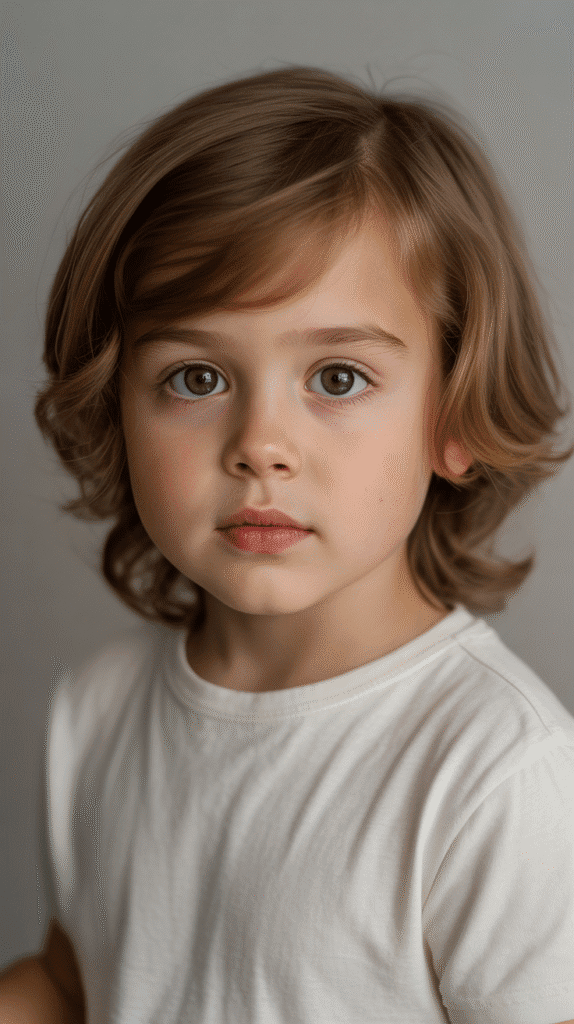
The center-parted longer hair creates a symmetrical, balanced appearance that suits toddlers with naturally straight or slightly wavy hair.
This classic styling approach brings timeless elegance to longer children’s haircuts.
- Hair length measures 3-5 inches throughout, with sufficient length for the center part to create distinct curtain-like sections on either side.
- The center part adds structure to longer hair, preventing it from appearing shapeless or unkempt even without styling products.
- This style works particularly well for toddlers with oval or heart-shaped faces, as the symmetry enhances natural facial balance.
- Creating the center part requires simply combing damp hair backward from the hairline’s center point, then allowing it to fall naturally.
- The longer length provides versatility for special occasions when parents might add temporary styling products or accessories.
- This haircut photographs beautifully from the front, creating classic images that capture childhood innocence and sweetness.
- Regular conditioning maintains the smooth appearance needed for the center part to remain defined and attractive.
19. Longer Pompadour Style
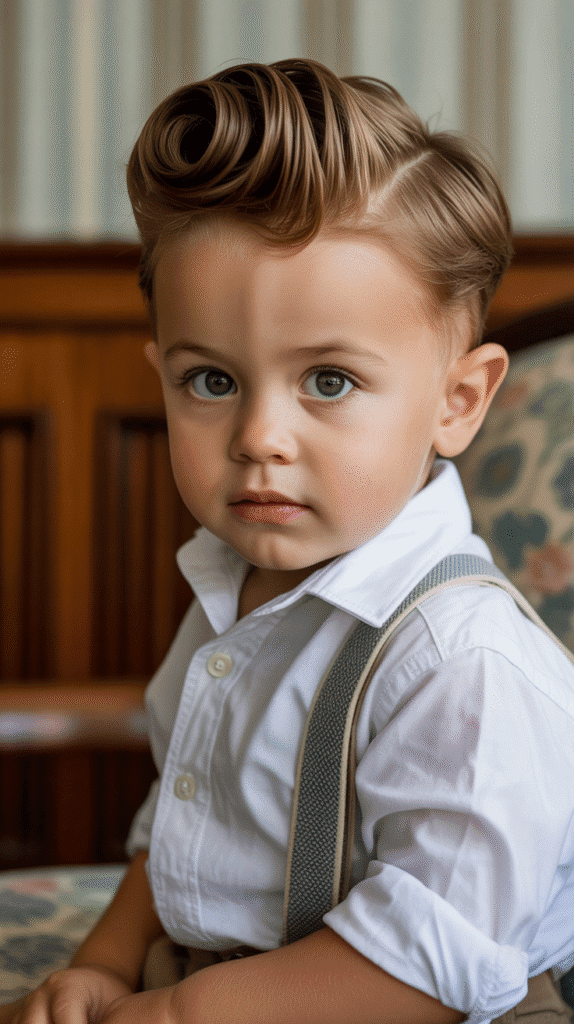
The longer pompadour style brings vintage-inspired flair to modern toddler haircuts while incorporating extended lengths.
This statement-making option suits confident little personalities and style-forward families.
- Front hair measures 4-5 inches, providing sufficient length to create the characteristic pompadour height and volume.
- Sides taper to 1-2 inches, shorter than the top but not dramatically so, maintaining the “longer” haircut classification.
- Creating the pompadour shape requires blow-drying front hair upward and backward with a small amount of styling product.
- This style particularly suits special occasions, celebrations, and photo sessions rather than everyday active play.
- The longer pompadour works best with straight to slightly wavy hair that holds shape when styled with lightweight products.
- Parents can leave the pompadour unstyled for casual days, allowing hair to fall naturally forward into a different but still attractive look.
- This haircut makes a memorable style statement that creates distinctive, personality-filled photographs.
20. Free-Form Longer Curls
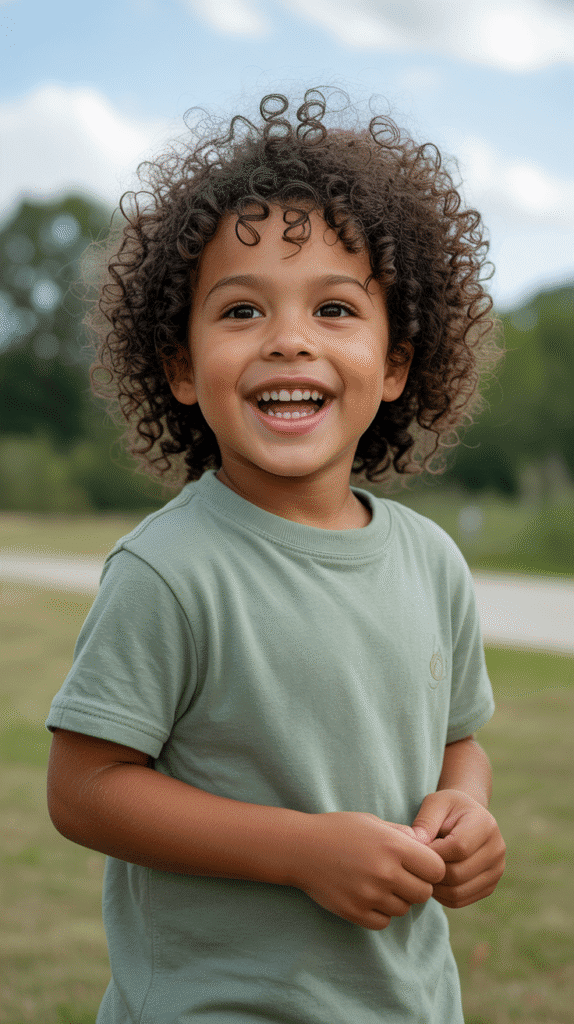
The free-form longer curls approach allows naturally curly-haired toddler boys to wear hair at extended lengths without constraint or forced styling.
This liberating option celebrates natural curl patterns in their full glory.
- Curl length extends to 4-6 inches when stretched, though curls naturally contract to appear shorter due to their spiral patterns.
- The cutting philosophy involves minimal intervention, focusing on shape maintenance and occasional trimming of damaged ends only.
- This style requires specialized curly hair care routines, including sulfate-free shampoos, deep conditioning treatments, and detangling on wet hair only.
- Free-form curls create stunning visual volume and texture that becomes a defining characteristic of the child’s appearance.
- Parents should embrace the unpredictability of curls, understanding that humidity, weather, and activity levels affect daily appearance.
- This approach works for all curl types, from loose waves to tight coils, each creating uniquely beautiful results.
- The free-form philosophy extends beyond haircuts to represent acceptance and celebration of natural characteristics.
21. Long Top Brushed Forward
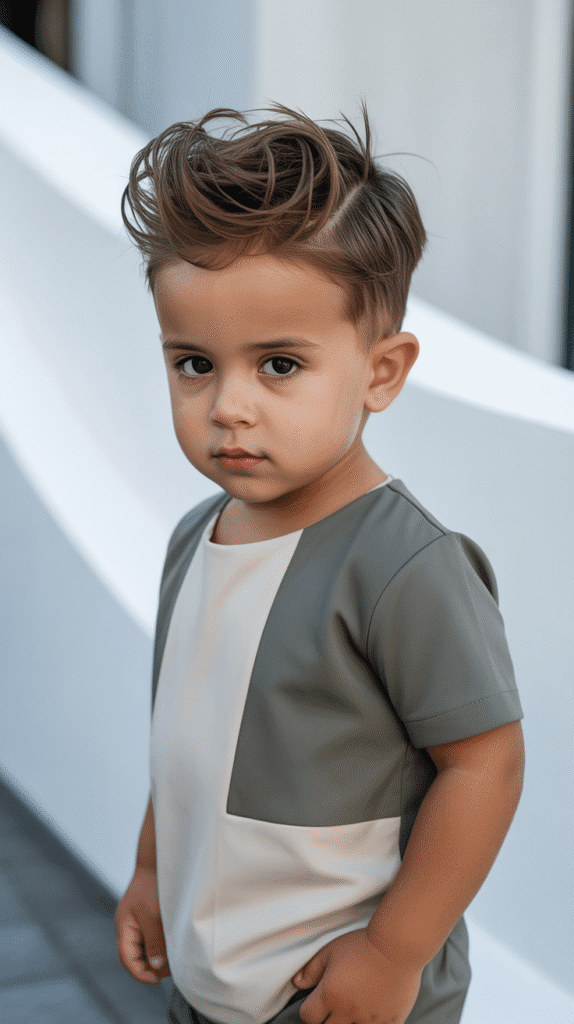
The long top brushed forward style creates a modern, youthful appearance by directing longer hair toward the face.
This contemporary option provides easy styling with fashionable results.
- Top hair measures 3-4 inches, providing sufficient length to brush forward convincingly while maintaining the style’s shape throughout the day.
- Sides and back remain moderately short at 1-2 inches, creating subtle contrast without extreme disconnection.
- The forward-brushed direction makes this style particularly easy to achieve during morning routines with just a comb and damp hair.
- This haircut works well for active toddlers, as the forward direction naturally keeps hair from falling into awkward positions during play.
- The style suits most face shapes, though it particularly complements longer faces by adding horizontal visual weight.
- A small amount of lightweight styling cream helps maintain the forward direction, though the haircut looks acceptable even without products.
- This option photographs dynamically, creating modern images that capture current styling trends while remaining timelessly youthful.
22. Graduated Long Layers
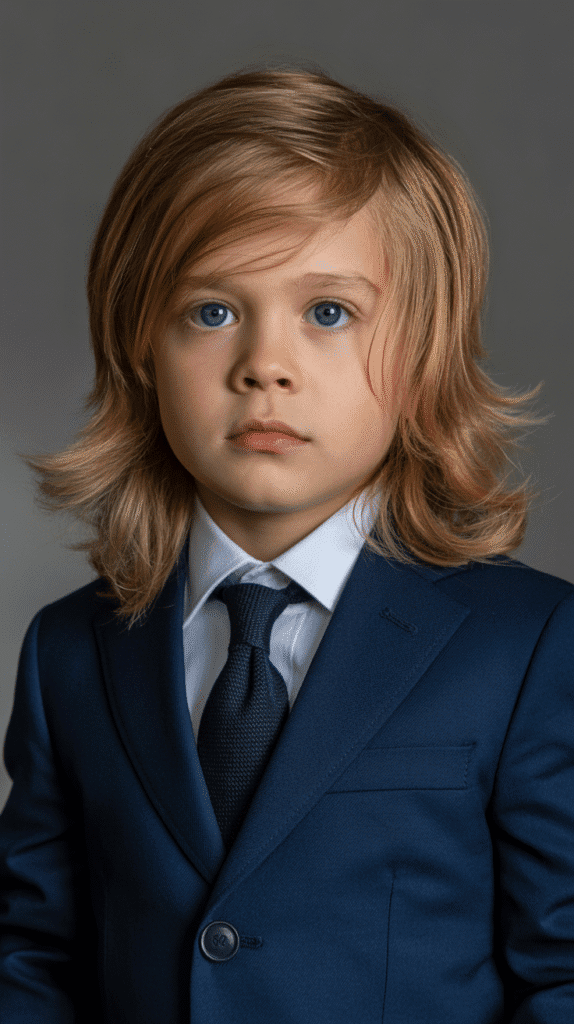
The graduated long layers haircut features strategic length progression that creates dimension while maintaining overall longer hair.
This sophisticated option delivers professional results that grow out beautifully.
- Hair length ranges from 2 inches at the nape gradually increasing to 4-5 inches at the crown, creating subtle elevation and volume.
- The graduated layering removes weight from the bottom while preserving fullness at the top, preventing flat appearance.
- This cutting technique works across all hair textures, with specific graduation angles adjusted based on whether hair is straight, wavy, or curly.
- The professional appearance makes this suitable for toddlers whose families prefer polished, well-maintained looks over casual styles.
- Graduated layers require skilled cutting, making it important to choose experienced stylists familiar with advanced layering techniques.
- This haircut maintains its shape beautifully as it grows, looking intentional even when several weeks past the original cutting date.
- The sophisticated nature of graduated layers creates elegant photographs perfect for professional portraits and family documentation.
Styling Tips for Longer Toddler Hair
Maintaining longer haircuts on toddler boys requires specific approaches that differ from adult hair care routines.
Understanding these fundamental techniques helps parents successfully manage extended lengths while keeping their little ones comfortable.
- Invest in quality children’s hair products specifically formulated for young, developing hair that tends to be finer and more delicate than adult hair.
- Establish consistent detangling routines using wide-tooth combs on wet, conditioned hair rather than brushing dry hair which can cause breakage and discomfort.
- Create positive associations with hair care time by incorporating songs, videos, or special activities that make the experience enjoyable rather than stressful.
- Schedule haircuts during optimal times when toddlers are well-rested and fed, typically mid-morning or early afternoon, avoiding cranky periods near nap time.
- Use distraction techniques during styling sessions, including mirrors positioned so children can watch the process or handheld devices showing favorite content.
- Apply leave-in conditioning sprays before bedtime to minimize morning tangles, making wake-up grooming sessions significantly easier for everyone involved.
- Consider protective nighttime measures like satin pillowcases that reduce friction-related tangles compared to standard cotton bedding materials.
- Keep styling expectations realistic for active toddlers, accepting that perfectly groomed hair may last only minutes before play inevitably disrupts careful styling work.
- Communicate with childcare providers about your child’s hair routine, providing necessary products and tools so consistency continues throughout the day.
- Photograph the haircut immediately after salon visits from multiple angles, giving you reference images to show stylists at future appointments for consistency.
Choosing the Right Length for Your Toddler
Selecting appropriate longer hair length for toddler boys involves balancing aesthetic preferences with practical considerations unique to young children.
Several factors should influence this important decision.
- Consider your child’s activity level honestly—highly active toddlers who constantly run, climb, and play may struggle with hair that regularly falls into their eyes or requires frequent adjustment.
- Evaluate your available time commitment for daily hair maintenance, as longer styles universally require more attention than shorter cuts even when labeled “low-maintenance.”
- Assess your toddler’s tolerance for grooming activities, including hair washing, detangling, and styling, as longer hair multiplies the frequency and duration of these sessions.
- Factor in climate and season when choosing length, recognizing that longer hair can cause overheating discomfort during summer months or in warmer climates.
- Consider hair texture carefully because different textures behave distinctly at longer lengths—fine straight hair may appear limp while thick curly hair gains impressive volume.
- Discuss with your stylist about your lifestyle, daily routines, and realistic maintenance capabilities before committing to significantly longer styles.
- Start gradually if transitioning from shorter cuts, growing hair incrementally while learning management techniques rather than jumping immediately to maximum length.
- Monitor your child’s comfort continuously after selecting longer styles, watching for signs of frustration like frequent touching, pulling, or complaints about hair bothering them.
- Remain flexible and willing to adjust length if the chosen style proves impractical for your specific situation despite initially appealing aesthetically.
- Remember growth is reversible—if longer hair doesn’t work as planned, cutting back doesn’t represent failure but rather smart adaptation to your family’s needs.
Hair Care Products for Longer Toddler Hair
Proper product selection significantly impacts the success and manageability of longer toddler boy haircuts.
Understanding which formulations work best helps parents make informed purchasing decisions.
- Choose sulfate-free shampoos designed for children, as harsh sulfates can strip natural oils that longer hair needs for health and manageability.
- Invest in quality conditioners appropriate for your child’s hair texture, using them at every washing to prevent the tangles that plague longer styles.
- Consider leave-in conditioning sprays as daily essentials for longer hair, applying them to damp hair after washing and before bedtime to minimize tangles.
- Select lightweight styling products when needed, avoiding heavy adult formulations that can weigh down fine toddler hair and create buildup.
- Look for tear-free formulations even for older toddlers, as the bathing experience should remain comfortable rather than becoming something children dread.
- Try detangling brushes with flexible bristles specifically designed for children, which work more gently through knots than standard adult brushes.
- Avoid products containing harsh chemicals including parabens, phthalates, and artificial fragrances that can irritate sensitive young scalps.
- Use natural oil treatments sparingly—coconut, argan, or jojoba oils applied to ends can improve condition without creating greasiness when used conservatively.
- Keep products age-appropriate by reading labels carefully and selecting formulations explicitly designed for toddlers and young children rather than older kids or adults.
- Test new products gradually by trying small amounts initially to check for allergic reactions or scalp sensitivity before incorporating them into regular routines.
Managing Tangles in Longer Hair
Tangles represent the primary challenge parents face when maintaining longer haircuts on toddler boys.
Implementing effective strategies minimizes discomfort and frustration during hair care routines.
- Never brush dry hair on toddlers with longer styles, as this causes unnecessary breakage and painful pulling that creates negative associations with grooming.
- Apply conditioner generously during bath time, allowing it to sit for 1-2 minutes before rinsing to maximize detangling benefits.
- Use detangling spray on damp hair immediately after washing and before bedtime to prevent knots from forming overnight during sleep movement.
- Work from bottom to top when combing through tangles, starting at the ends and gradually moving upward rather than starting at the roots which worsens knots.
- Section hair systematically for thorough detangling, dividing longer hair into quadrants and working through each section completely before moving to the next area.
- Invest in a quality wide-tooth comb made from smooth materials like seamless plastic or wood that glide through hair without catching or snagging.
- Create positive distraction during detangling sessions by positioning your toddler in front of favorite shows, videos, or interactive apps that capture attention.
- Hold hair at the mid-shaft while working through tangles below, which prevents pulling pain at the scalp that makes children resist grooming.
- Apply slight tension downward rather than pulling sideways or upward when encountering resistance, as this approach releases knots more gently.
- Consider protective hairstyles for sleep like loose braids or low ponytails (if your toddler tolerates them) that minimize friction-related tangling overnight.
- Replace cotton pillowcases with satin or silk alternatives that create less friction against hair during sleep movements throughout the night.
- Address tangles immediately when discovered rather than waiting, as small knots quickly worsen into larger mats that require significantly more effort to resolve.
- Reward cooperation with praise, stickers, or small incentives that create positive associations with hair care rather than battles and resistance.
- Know when to seek help from professional stylists who can remove severe mats without traumatizing your child if home efforts prove unsuccessful.
- Reassess hair length honestly if tangles become a constant source of stress and tears despite implementing all recommended strategies.
Seasonal Considerations for Longer Styles
Different seasons present unique challenges and opportunities for longer toddler boy haircuts.
Adjusting care routines seasonally ensures comfort and manageability throughout the year.
- Summer heat demands extra attention to scalp health, as longer hair can trap heat and create discomfort during outdoor play in high temperatures.
- Increase washing frequency during warmer months when sweat, sunscreen, and swimming activities introduce more dirt and product buildup into longer hair.
- Apply leave-in UV protection products designed for children’s hair when spending extended time outdoors, as sun exposure can damage and dry longer lengths.
- Consider temporary length reduction during peak summer months if your toddler shows signs of heat-related discomfort or frequently asks to cut their hair.
- Winter dryness requires moisturizing adjustments including more intensive conditioning treatments and reduced washing frequency to preserve natural oils.
- Combat static electricity common in winter using anti-static sprays or light conditioning products that prevent flyaway hair and uncomfortable static shocks.
- Protect hair from harsh winter elements by using hats during outdoor play, though ensure hats aren’t so tight they create uncomfortable pressure or flatten hairstyles completely.
- Adjust indoor humidity levels with humidifiers during winter heating seasons, as extremely dry air negatively impacts hair condition and increases breakage.
- Spring allergies may increase itching leading to more frequent touching and scratching that can damage longer hair and disrupt styled appearances.
- Fall preparation involves transitioning from summer routines back to school schedules, potentially requiring more structured styling appropriate for classroom environments.
- Monitor seasonal activity changes that affect how practical certain longer styles remain—winter indoor play differs significantly from summer water activities.
- Adjust appointment scheduling around seasonal events, avoiding major haircut changes right before important occasions like holidays, birthdays, or family photos.
Working with Different Hair Textures
Successfully maintaining longer toddler boy haircuts requires understanding how different hair textures behave at extended lengths.
Customizing approaches based on specific texture characteristics produces optimal results.
Straight Hair Considerations
- Straight hair shows length most dramatically as it hangs directly downward without curl contraction, making it appear longer than curly hair of identical measured length.
- Fine straight hair can appear limp at longer lengths, benefiting from layering techniques that create movement and prevent flat, lifeless appearance.
- Thick straight hair gains weight as length increases, sometimes pulling out natural volume at roots and creating a heavy, triangular silhouette without proper cutting techniques.
- Straight textures require less moisturizing product than curly hair but still need conditioning to prevent static and maintain shine at longer lengths.
Wavy Hair Characteristics
- Wavy patterns become more defined as hair grows longer and weight pulls waves into more pronounced S-shaped patterns throughout the hair shaft.
- Wavy hair offers styling versatility that works both enhanced with curl-defining products or smoothed into straighter styles depending on the occasion.
- Frizz management becomes important with wavy textures, requiring anti-humidity products during damp weather to maintain defined wave patterns rather than frizzy appearance.
- Wavy hair benefits from scrunching techniques applied to damp hair with lightweight styling products to encourage natural wave formation.
Curly and Coily Hair Needs
- Curly hair requires specialized care fundamentally different from straight hair approaches, including completely different product formulations and styling techniques.
- Moisture is absolutely critical for curly textures, requiring leave-in conditioners, curl creams, and regular deep conditioning treatments to maintain health.
- Never brush dry curly hair as this destroys curl patterns and creates frizz—detangling must occur on wet, conditioned hair using wide-tooth combs or fingers.
- Shrinkage is natural and expected with curly textures, so hair measuring 5 inches stretched may appear only 2-3 inches when dry and curled naturally.
- Embrace the volume that curly hair creates rather than fighting against it, as longer curly hair gains impressive three-dimensional presence.
- Find curl-specialized stylists who understand proper cutting techniques for curly hair, as traditional straight-hair cutting approaches produce poor results on curls.
Communicating with Your Child’s Stylist
Establishing effective communication with your toddler’s hair stylist ensures consistent results and positive experiences.
Clear dialogue prevents misunderstandings and disappointments.
- Bring reference photos showing exactly what you want from multiple angles, as verbal descriptions alone often lead to mismatched expectations versus results.
- Discuss your daily routine honestly including available morning time, your child’s cooperation level, and realistic maintenance capabilities you can consistently provide.
- Explain your child’s temperament so stylists can adjust their approach—some toddlers respond well to chatty engagement while others prefer quiet, quick work.
- Ask about growing-out timelines if you’re transitioning toward longer styles, understanding realistic expectations for how long achieving desired length will require.
- Request specific maintenance instructions including product recommendations, styling techniques, and how frequently trims will be needed to maintain the chosen style.
- Inquire about modification options within the chosen style so you understand available variations for different occasions or if initial results need adjusting.
- Schedule appointments strategically at times when your child is typically well-rested and cooperative, avoiding slots near nap time or meal times.
- Establish a regular stylist relationship rather than visiting different people each time, as consistency helps your child feel comfortable and stylists learn specific preferences.
- Provide feedback constructively after appointments, sharing what worked well and what could improve to refine future results progressively.
- Ask questions freely about anything unclear rather than leaving uncertain and attempting to figure out techniques at home through trial and error.
When to Transition Back to Shorter Styles
Recognizing when longer hair no longer serves your toddler’s best interests requires honest assessment and flexibility.
Several indicators suggest transitioning to shorter lengths might be appropriate.
- Constant complaints from your child about hair bothering them, getting in their eyes, or feeling uncomfortable signal genuine distress that deserves respect.
- Frequent tangling crises that result in tears, extended battles, and negative associations with hair care suggest the length exceeds manageable limits.
- Regular overheating issues during play or sleep indicate the hair length creates physical discomfort that affects your child’s wellbeing.
- Your stress levels surrounding hair maintenance affect family dynamics negatively, creating tension that outweighs the aesthetic benefits of longer hair.
- Developmental changes like increased independence and resistance to grooming assistance make maintaining longer styles impractical as toddlers assert autonomy.
- Safety concerns arise if longer hair poses hazards during specific activities your child enjoys, like certain sports or playground equipment.
- Skin problems including rashes, acne, or irritation on the neck, forehead, or ears may result from longer hair contact and trapped sweat.
- Time constraints in your family schedule make adequate hair care increasingly difficult as responsibilities multiply with growing families or changing work demands.
- Your child expresses preferences for shorter hair after seeing peers or older siblings with different styles they find appealing.
- Remember cutting hair doesn’t represent failure but rather responsive parenting that prioritizes your child’s comfort and your family’s practical needs over aesthetic preferences.
Building Positive Hair Care Routines
Creating sustainable, positive hair care habits during toddler years establishes foundations for lifelong healthy relationships with personal grooming.
Intentional routine-building yields long-term benefits.
- Establish consistent timing for hair care activities so children know what to expect, reducing resistance born from unpredictability and surprise.
- Make bath time enjoyable through special toys, songs, or games used exclusively during hair washing that create positive associations rather than dreaded obligations.
- Involve your child in age-appropriate ways like letting them hold the spray bottle, choose which conditioner scent to use, or select detangling clips.
- Use visual schedules showing the hair care routine sequence with pictures, helping toddlers understand the process and reducing anxiety about unknown steps.
- Praise cooperation enthusiastically rather than only addressing problems, reinforcing positive behavior with specific compliments about sitting still, turning their head when asked, or being patient.
- Keep sessions brief whenever possible, recognizing toddler attention spans are limited and lengthy grooming sessions inevitably lead to resistance and frustration.
- Create special rituals around hair care like the “detangling song” you always sing or the funny face you make in the mirror afterward that builds anticipation.
- Model healthy attitudes toward your own grooming by letting your child watch you care for your hair while explaining what you’re doing and why.
- Never use hair care as punishment or threats like “if you don’t behave we’ll have to cut it all off,” which creates anxiety and negative emotions around grooming.
- Celebrate milestones like the first time your child detangles cooperatively without tears or when they help apply their own conditioner with appropriate enthusiasm.
- Stay patient and flexible on difficult days, understanding that sometimes quick, imperfect hair care is acceptable rather than forcing battles that damage your relationship.
- Seek solutions collaboratively by asking your toddler what would make hair time easier, sometimes receiving surprisingly helpful feedback about preferred positions, products, or approaches.
Budget-Friendly Longer Hair Maintenance
Maintaining longer toddler boy haircuts doesn’t require expensive products or frequent salon visits.
Smart strategies keep costs reasonable while achieving excellent results.
- Extend time between cuts by choosing styles that grow out attractively, as longer haircuts generally maintain acceptable appearance for 8-12 weeks versus shorter styles requiring monthly trims.
- Invest in fewer, quality products rather than accumulating many mediocre items—one excellent shampoo, conditioner, and detangling spray cover essential needs effectively.
- Look for children’s product sales and stock up when favorite items are discounted, as unopened hair care products have long shelf lives and buying bulk saves money.
- Consider DIY trims for simple bang maintenance between professional cuts, investing in quality hair scissors and watching tutorial videos for basic techniques.
- Use multi-purpose products like leave-in conditioners that work as both detanglers and light styling products, reducing the number of separate purchases needed.
- Shop generic or store brands for basic items like shampoo, as many affordable options perform comparably to expensive name brands for young children’s hair care needs.
- Make homemade detangling spray using water, a few drops of conditioner, and optional essential oils in a spray bottle for pennies per batch.
- Protect hair during sleep with inexpensive satin pillowcases that reduce tangles, potentially decreasing conditioning product usage and extending time between washes.
- Request student stylist appointments at beauty schools where supervised students provide significantly discounted services perfect for simple children’s haircuts.
- Join salon loyalty programs offering discounts, birthday freebies, or rewards points that accumulate into savings over multiple appointments.
- Wash less frequently when appropriate for your child’s activity level and hair type, as over-washing increases product usage and costs unnecessarily.
- Repurpose adult products carefully for some items like conditioners or oils, testing small amounts to ensure they work well with your child’s finer hair texture before committing.
Health and Safety Considerations
Longer hair on toddler boys requires specific health and safety awareness to prevent problems while maintaining the attractive appearance parents desire.
- Monitor scalp health regularly by checking for redness, flaking, unusual odors, or sensitivity that might indicate developing conditions requiring attention.
- Ensure thorough rinsing during washing to prevent product buildup that can cause scalp irritation, itching, or even contribute to infection in severe cases.
- Watch for excessive hair pulling by your child, which might indicate discomfort from tangles, style tightness, or could signal stress-related behaviors needing addressing.
- Check for pests regularly as longer hair can make detecting lice or other issues more difficult—examine the scalp weekly especially if your child attends group care.
- Prevent choking hazards by keeping hair accessories, styling products, and small items used during grooming safely stored away from toddler reach.
- Avoid extremely tight hairstyles like ponytails or braids pulled taut, as these can cause traction alopecia (hair loss from pulling) and scalp discomfort.
- Be cautious near water as longer wet hair can obstruct vision during swimming or bathing, potentially creating safety issues if children can’t see clearly.
- Keep hair away from equipment during play, ensuring longer styles don’t pose entanglement risks on playground structures, bicycles, or other gear.
- Use safe styling tools designed for children with appropriate heat settings if blow-drying becomes necessary, protecting developing hair from heat damage.
- Address hygiene concerns proactively if longer hair increases sweating or traps dirt more readily, adjusting washing frequency to maintain cleanliness.
- Watch for allergic reactions to new products by introducing them gradually and monitoring for redness, itching, rashes, or other sensitivity signs.
- Consult healthcare providers if you notice unusual hair loss, dramatic texture changes, or persistent scalp problems that don’t resolve with basic care adjustments.
Cultural and Social Considerations
Longer hair on toddler boys exists within cultural contexts and social environments that influence experiences and perceptions.
Awareness of these dimensions helps families navigate potential challenges.
- Recognize cultural variations in hair length acceptability and styling traditions, understanding that practices vary significantly across different communities and backgrounds.
- Prepare for comments from extended family, friends, or strangers who may express opinions about longer hair on boys, developing responses that feel comfortable for your family.
- Support your child if they encounter teasing or questions from peers about their longer hair, providing age-appropriate language to explain their style confidently.
- Celebrate diverse representation by showing your child images of boys and men with various hair lengths and styles, normalizing the full spectrum of appearance choices.
- Connect with similar families through online communities or local groups where longer hair on boys is common and celebrated rather than questioned.
- Educate respectfully when encountering misgendering due to longer hair by politely correcting without shaming, recognizing genuine mistakes happen especially with young children.
- Honor your child’s identity by ensuring longer hair represents choices that feel authentic to your family rather than conforming to or rebelling against external pressures.
- Address your own biases honestly about gender, appearance, and conformity, examining whether longer hair decisions stem from genuine preference or other motivations.
- Remain flexible as your child develops their own opinions about appearance, supporting their emerging preferences even if they differ from your initial choices.
- Focus on health and happiness as primary considerations rather than others’ opinions, keeping perspective about what truly matters for your child’s wellbeing.
Transitioning from Baby Fine Hair
As toddlers grow, hair texture and density often change significantly from infant characteristics.
Understanding these transitions helps manage expectations with longer styles.
- Baby hair gradually thickens between ages 18 months to 3 years, meaning styles that worked initially may need modification as density increases.
- Texture often changes from infant straight or slightly wavy hair to curlier or coarser patterns reflecting genetic traits more accurately.
- Color typically deepens from lighter infant shades to truer permanent colors, which might affect how certain haircut styles appear aesthetically.
- Growth patterns become established showing cowlicks, natural parts, or directional growth that influences which longer styles work best practically.
- Previous styles may suddenly look different as hair changes require adapting cuts to work with new texture, thickness, and growth patterns.
- Styling product needs evolve as thicker, coarser hair requires different formulations than the baby-fine texture that existed months earlier.
- Be patient during transitions when hair seems to have an awkward in-between appearance as it shifts from one stage to another developmentally.
- Communicate changes with your stylist so they can adjust cutting techniques appropriately for your child’s current hair characteristics rather than previous texture.
- Photograph hair periodically to document changes over time, helping you notice gradual shifts that might not be obvious from daily observation.
- Adjust expectations realistically as certain styles imagined during the baby stage may not work once true hair texture emerges more fully.
Conclusion
22 Longer Toddler Boy Haircuts for a Stylish Look demonstrates that maintaining extended hair lengths on young boys combines aesthetic appeal with practical considerations that families can successfully navigate together.
From classic shaggy cuts to contemporary disconnected styles, the diverse options presented accommodate various hair textures, lifestyle demands, and personal preferences that make each family unique.
While longer toddler haircuts require increased maintenance commitment compared to shorter styles, the results deliver versatility, personality expression, and memorable childhood aesthetics that many parents deeply value.
Success with longer hair depends on realistic expectations, consistent care routines, quality products appropriate for young children, and most importantly, prioritizing your child’s comfort and wellbeing above external opinions or rigid aesthetic goals.
Whether you choose flowing surfer waves, textured layers, or polished side-parted elegance, the key lies in selecting styles that genuinely fit your family’s daily reality while celebrating your toddler’s individual charm.
Remember that hair grows, preferences evolve, and flexibility serves families better than perfectionism—embrace the journey of discovering which longer styles work beautifully for your little one’s specific needs and characteristics.
